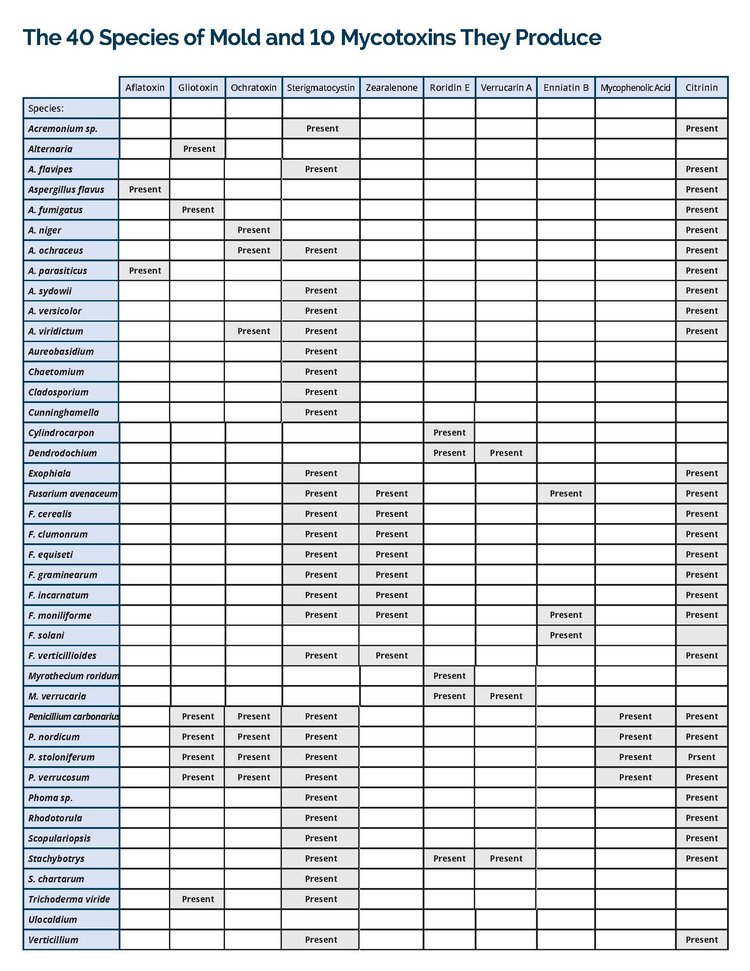Sample Required: Urine | Test Type: Toxicity
Mycotoxins are some of the most prevalent toxins in the environment. Mycotoxins are metabolites produced by fungi like mould, which can infest buildings, vehicles, and foodstuffs. A majority of mycotoxin exposures are through food ingestion or airborne exposure.
In the European Union, 20% of all grains harvested have been found to be contaminated with mycotoxins. Unfortunately, mycotoxins are resistant to heat and many processing procedures.
Fungi are able to grow on almost any surface, especially if the environment is warm and wet. Inner wall materials of buildings, wall paper, fibreglass insulation, ceiling tiles, and drywall (Gyprock) are all good surfaces for fungi to colonise.
These fungi then release mycotoxins into the environment which may cause symptoms of many different chronic diseases. Diseases and symptoms that may be linked to mycotoxin exposure include fever, pneumonia-like symptoms, heart disease, rheumatic disease, asthma, sinusitis, memory loss, vision loss, chronic fatigue, skin rashes, depression, ADHD, anxiety, and liver damage.
If you or a patient has done a GPL-MycoTOX Profile and the results show moderate to high levels of mycotoxins there are things you can do to help the body eliminate the toxins and prevent future exposures. The first step is to eliminate or reduce exposure to mould. The majority of exposures result from contaminated food, skin contact, and inhalation of spore-borne toxins, which is often caused by water-damaged buildings. Inhalation of spore-borne toxins can be limited by detecting and eliminating damp and mouldy environments, both indoor and outdoor.
Mould can enter homes through open windows, vents, doorways, and heating and air conditioning systems. Mould grows well on organic products such as paper, wood, cardboard, and ceiling tiles.
Mould can also grow on insulation, drywall, wallpaper, carpet, fabric, and upholstery. Mould can be controlled by cleaning and drying after water intrusion; having proper ventilation for showers, laundry, and cooking areas; making sure that windows, roofs, and pipes are free of leaks; and by controlling humidity levels. After moisture problems are alleviated it is recommended that mould removal be performed by a licensed contractor.
Attempts to remove mould may cause mould spores to scatter and spread to other areas. In addition, treating mould without proper ventilation could result in health problems caused by the release of mycotoxins from the mould spores.
Aflatoxin M1 (AFM1) is the main metabolite of aflatoxin B1, which is a mycotoxin produced by the mould species Aspergillus. Aflatoxin susceptibility is dependent on multiple different factors such as age, sex, and diet. Aflatoxin can be found in beans, corn, rice, tree nuts, wheat, milk, eggs, and meat. In cases of lung aspergilloma, aflatoxin has been found in human tissue specimens. Aflatoxin can cause liver damage, cancer, mental impairment, abdominal pain, hemorrhaging, coma, and death. Aflatoxin has been shown to inhibit leucocyte proliferation. Clinical signs of aflatoxicosis are non-pruritic macular rash, headache, gastrointestinal dysfunction (often extreme), lower extremity edema, anemia, and jaundice. The toxicity of Aflatoxin is increased in the presence of Ochratoxin and Zearalenone.
Ochratoxin A (OTA) is a nephrotoxic, immunotoxic, and carcinogenic mycotoxin. This chemical is produced by moulds in the Aspergillus and Penicillium families. Exposure is primarily through contaminated foods such as cereals, grape juices, dairy, spices, wine, dried vine fruit, and coffee. Exposure to OTA can also come from inhalation exposure in water-damaged buildings. OTA can lead to kidney disease and adverse neurological effects. Studies have shown that OTA can cause significant oxidative damage to multiple brain regions and the kidneys. Dopamine levels in the brain of mice have been shown to be decreased after exposure to OTA.
Sterigmatocystin (STG) is a mycotoxin that is closely related to aflatoxin. STG is produced from several species of mould such as Aspergillus, Penicillium, and Bipolaris. It is considered to be carcinogenic, particularly in the cells of the GI tract and liver. STG has been found in the dust from damp carpets. It is also a contaminant of many foods including grains, corn, bread, cheese, spices, coffee beans, soybeans, pistachio nuts, and animal feed. In cases of lung aspergilloma, STG has been found in human tissue specimens. The toxicity of STG affects the liver, kidneys, and immune system. Tumors have been found in the lungs of rodents that were exposed to STG. Oxidative stress becomes measurably elevated during STG exposure, which causes a depletion of antioxidants such as glutathione, particularly in the liver.
Roridin E is a macrocyclic trichothecene produced by the mould species Fusarium, Myrothecium, and Stachybotrys (i.e. black mould). Trichothecenes are frequently found in buildings with water damage but can also be found in contaminated grain. This is a very toxic compound, which inhibits protein biosynthesis by preventing peptidyl transferase activity. Trichothecenes are considered extremely toxic and have been used as biological warfare agents. Even low levels of exposure to macrocyclic trichothecenes can cause severe neurological damage, immunosuppression, endocrine disruption, cardiovascular problems, and gastrointestinal distress.
Verrucarin A is a macrocyclic trichothecene mycotoxin produced from Stachybotrys, Fusarium, and Myrothecium. Trichothecenes are frequently found in buildings with water damage but can also be found in contaminated grain. This is a very toxic compound, which inhibits protein biosynthesis by preventing peptidyl transferase activity. Trichothecenes are considered extremely toxic and have been used as biological warfare agents. Even low levels of exposure to macrocyclic trichothecenes can cause severe neurological damage, immunosuppression, endocrine disruption, cardiovascular problems, and gastrointestinal distress.
Enniatin B1 is a fungal metabolite categorised as cyclohexa depsipeptides toxin produced by the fungus Fusarium. This strain of fungus is one of the most common cereal contaminants. Grains in many different countries have recently been contaminated with high levels of enniatin. The toxic effects of enniatin are caused by the inhibition of the acyl-CoA cholesterol acyltransferase, depolarisation of mitochondria, and inhibition of osteoclastic bone resorption. Enniatin has antibiotic properties and chronic exposure may lead to weight loss, fatigue, and liver disease.
Zearalenone (ZEA) is a mycotoxin that is produced by the mould species Fusarium, and has been shown to be hepatotoxic, haematotoxic, immunotoxic, and genotoxic. ZEA is commonly found in several foods in the US, Europe, Asia, and Africa including wheat, barley, rice, and maize. ZEA has estrogenic activity and exposure to ZEA can lead to reproductive changes. ZEA’s estrogenic activity is higher than that of other non-steroidal isoflavones (compounds that have estrogen-like effects) such as soy and clover. ZEA exposure can result in thymus atrophy and alter spleen lymphocyte production as well as impaired lymphocyte immune response, which leads to patients being susceptible to disease.
Gliotoxin (GTX) is produced by the mould genus Aspergillus. Aspergillus spreads in the environment by releasing conidia which are capable of infiltrating the small alveolar airways of individuals. In order to evade the body’s defenses Aspergillus releases gliotoxin to inhibit the immune system. One of the targets of gliotoxin is PtdIns (3,4,5) P3. This results in the downregulation of phagocytic immune defense, which can lead to the exacerbation of polymicrobial infections. Gliotoxin impairs the activation of T-cells and induces apoptosis in monocytes and in monocyte-derived dendritic cells. These impairments to dendritic cells can lead to multiple neurological syndromes.
Mycophenolic Acid (MPA) is produced by the Penicillium fungus. MPA is an immunosuppressant which inhibits the proliferation of B and T lymphocytes. MPA exposure can increase the risk of opportunistic infections such as Clostridia and Candida. MPA is associated with miscarriage and congenital malformations when the woman is exposed in pregnancy.
Chaetoglobosin A (CHA) is produced by the mold Chaetomium globosum (CG). CG is commonly found in homes that have experienced water damage. Up to 49% of water-damaged buildings have been found to have CG. CHA is highly toxic, even at minimal doses. CHA disrupts cellular division and movement. Most exposure to CG is through the mycotoxins because the spores tend not to aerosolize. Exposure to CHA has been linked to neuronal damage, peritonitis, and cutaneous lesions.
Aspergillus
Aspergillus is the most prevalent mould group in the environment. It has caused billions of dollars of in damage to crops and livestock. Two of the most common Aspergillus mycotoxins are aflatoxin and ochratoxin. The main target of these toxins is the liver. These toxins have been found in all major cereal crops including peanuts, corn, cotton, millet, rice, sorghum, sunflower seeds, wheat, and a variety of spices. They are also found in eggs, milk, and meat from animals fed contaminated grains. Diseases caused by Aspergillus are called aspergillosis. The most common route of infection is through the respiratory system. Aspergillus can cause severe asthma when the mould colonises the lung, forming a granulomatous disease.
Penicillum
There are over 200 species of Penicillium that have been discovered. Penicillium chrysogenum is the most common of these species. It is often found in indoor environments and is responsible for many allergic reactions. Penicillium is also a known contaminant in many different food items. Many different types of citrus fruits can become contaminated with Penicillium, but it can also contaminate seeds and grains. One reason that Penicillium is such a common infestation is because of its ability to thrive in low humidity. In the home, Penicillium can be found in wallpaper, carpet, furniture, and fiberglass insulation. The most common mycotoxin produced by Penicillium is ochratoxin (OTA). Ochratoxin is nephrotoxic, which means that it damages the kidneys. It is also carcinogenic.
Stachybotrys
Stachybotrys is a greenish-black mould. This mould can grow on materials with high cellulose and low nitrogen content such as gypsum board, paper, fiberboard, and ceiling tiles. Stachybotrys is known for its production of the highly toxic macrocyclic trichothecene mycotoxins. Two of the more common mycotoxins produced by Stachybotrys are roridin E and verrucarin. In addition to these mycotoxins, the fungus produces nine phenylspirodrimanes, as well as cyclosporine, which are potent immunosuppressors. These immunosupressors along with the mycotoxin trichothecenes may be responsible for the high toxicity of Stachybotrys.
Fusarium
Fusarium’s major mycotoxins are zearalenone (ZEN) and fumonisin. Fusarium fungi grow best in temperate climate conditions. They require lower temperatures for growth than Aspergillus. Fusarium grows worldwide on many different types of grains including corn and wheat. Exposure to mycotoxins from Fusarium can lead to both acute and chronic effects. These symptoms can include abdominal distress, malaise, diarrhea, emesis, and death. ZEN possesses estrogenic effects and has been implicated in reproductive disorders.


Check for water leaking from plumbing sources in bathrooms, kitchens, laundry areas, etc. If you see mould near water pipes, waste lines, icemaker lines, or other plumbing fixtures, there is probably a nearby plumbing leak.
Because they are dark, closets can be prime breeding grounds for mould, especially if your home is warm and humid, and/or if you ever put wet or damp clothing or towels in your closet. If you find mould in your closet, wash your clothes and other items immediately.
Fireplaces and chimneys are ideal for mould because they are often dark, damp, and poorly ventilated. Those not used often are particularly prone to mould growth. Mould can easily grow on bricks in your chimney or fireplace, then spread to other parts of your home.
Your laundry room is an ideal place for mould to develop. Moisture build-up and/or faulty washer and dryer connections can lead to mould growth on walls, pipes, and under leaky appliances. Make sure your clothes dryer has an anti-humidity vent. Humidity can also be reduced with a dehumidifier, an open window, or a good ventilation system with a ceiling vent.
Basements are dark, tend to be damp, and are often not well ventilated, making the floors and walls (especially if cement) ideal for mould growth. Mould in homes often starts growing in the basement and works its way up to other parts of the home. Basement mould can be difficult to eradicate without first addressing the underlying moisture and ventilation issues allowing the mould to flourish.
Mould in HVAC systems is common and can be quickly spread throughout the home by the forced air in the systems. According to the U.S. EPA, you should routinely inspect your HVAC systems, not just for mould, but for moisture. Check drain pans to be sure they are draining properly. Look at other components including the ducts and blowers, ensuring they are moisture-free. Keep your filters cleaned out regularly to avoid build-up of debris, which in combination with moisture, can lead to mould growth.
Check your roof for leaks regularly, especially during and after periods of heavy rain or snow. The leaks can cause water damage to your ceilings, and lead to mould growth in your home, especially in attics or crawl spaces. Algae or moss, especially on wood shingles, can eat through the shingles, priming the area for mould growth. Mould stains can also form on roof shingles that are in permanent shade. If left alone, these stains can discolor your roof and damage the shingles over time.
While mould grows best in warm, humid environments, it can tolerate the cold environment of a refrigerator. To assess potential mould growth in your refrigerator, look for mould on your food, dark mildew stains on the compartments of the fridge, and take notice of any foul or musty odors. Be sure to check the refrigerator door seals and the drain pan too, as these are places mould can often grow.
Examine food before you buy it. Foods commonly contaminated by mould include fresh produce, grains, cereals, corn, bread, cheese, spices, coffee beans, nuts, dried fruit, grape juice, and wine. Fresh meat and poultry are usually mould free, but cured and cooked meats may not be. Check your refrigerator regularly for spills or older items, which can create an ideal environment for mould to develop. When you see mould on the surface of foods, it may go much deeper. Heavy mould growth may create root threads that can move into the food, which may be quite toxic.